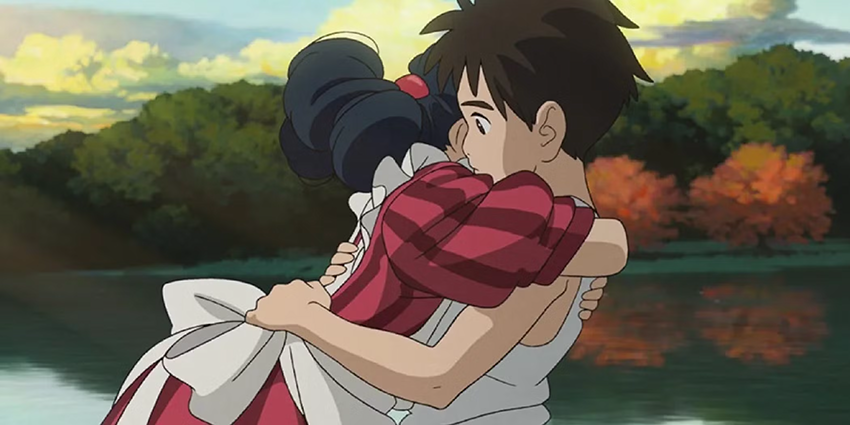Hayao Miyazaki’s latest film, The Boy and the Heron, is a sweeping, heart-wrenching journey through the realms of loss, resilience, and self-discovery. The beautiful animated film released in cinemas earlier this year, but is now streaming on Netflix.
As with Miyazaki’s previous works, The Boy and the Heron combines enchanting, magical landscapes with complex human emotions, drawing viewers into a story that is both personal and universal in its portrayal of grief.
Semi-autobiographical and inspired by Miyazaki’s own grappling with mortality, legacy, and the turbulent times in which we live, this film is a moving meditation on loss, reminiscent of Spirited Away and My Neighbour Totoro in its emotive power and thematic depth.
Set against the backdrop of Japan during World War II, The Boy and the Heron follows Mahito, a young boy who has recently lost his mother in a tragic fire. Forced to relocate to the countryside when his father remarries, Mahito struggles to adjust to his new life, harbouring a deep, simmering grief that colours his interactions with his surroundings. As he explores his new environment, he encounters a mysterious heron that beckons him into an alternate world—a fantastical, mystical realm full of wonder, danger, and revelations about life and death. Through his journey, Mahito is given an opportunity to confront his grief, encounter his mother’s memory, and understand the complexities of moving forward after loss.
One of the most striking aspects of The Boy and the Heron is its visual storytelling, which mirrors Mahito’s emotional state in ways both subtle and profound. Miyazaki has crafted a world that is at once enchanting and unsettling, filled with lush forests, shadowy caves, and vibrant meadows that evoke a sense of otherworldly beauty. Each frame reflects Mahito’s emotional journey, with colours and shapes mirroring his shifting moods—grey, stormy skies reflecting his sorrow, while scenes bathed in warm sunlight hint at moments of hope and resilience. The heron, with its majestic yet weird presence, serves as a symbol of Mahito’s inner conflict, representing both his memories of his mother and his desire to move beyond them.
Loss and grief are recurring themes in Miyazaki’s work, but here they take centre stage in a way that feels both timely and deeply personal. Mahito’s journey is one that many viewers will resonate with, as it explores the multifaceted nature of grief—not merely as sorrow but as a journey marked by confusion, anger, acceptance, and, ultimately, growth. Miyazaki does not shy away from the pain of loss but allows Mahito to experience and express it fully. In scenes that are as heart-wrenching as they are cathartic, Mahito confronts the reality of his mother’s absence, grappling with questions about her memory and how he can carry it forward.
The film’s narrative structure, drifting between Mahito’s everyday reality and his fantastical journey, effectively captures the unpredictable ebb and flow of grief. Miyazaki weaves these two worlds together, allowing Mahito’s experience of loss to permeate every aspect of the story, creating a sense of unity between his internal and external worlds. The alternate realm that Mahito enters is not an escape from his sorrow but rather a mirror that reflects and amplifies his emotions. Through encounters with creatures that represent different facets of life, death, and memory, Mahito learns that grief is not a barrier to be overcome but a process to be understood and accepted.
Both the Japanese and English voice acting, a beautiful orchestral score, and meticulous attention to detail further elevate the film’s emotional impact. The Japanese voice actors bring authenticity and raw emotion to their roles, particularly in scenes where Mahito interacts with his new stepmother, allowing viewers to feel the tension and complexity of relationships affected by loss. The English voice cast is also excellent, capturing the nuance and emotion of the original cast.
The music underscores Mahito’s journey with a haunting, melancholic tone, alternating between gentle melodies and intense, dramatic crescendos, echoing the highs and lows of his emotional arc.
In The Boy and the Heron, Miyazaki demonstrates once again his unparalleled ability to explore profound themes with tenderness and insight. The film’s message is not simply one of moving on but of embracing loss as part of life’s natural cycle, honouring those we have lost while continuing to live and grow. Mahito’s story is a reminder that even amid unimaginable loss, there is room for wonder, connection, and healing.
With this film, Miyazaki offers audiences a breathtaking and deeply resonant exploration of grief that is bound to leave a lasting impact on viewers young and old alike. The Boy and the Heron is a testament to the enduring beauty of life, even in the face of sorrow, and a masterpiece that will surely stand among Miyazaki’s finest works.
The Boy and the Heron is streaming on Netflix











